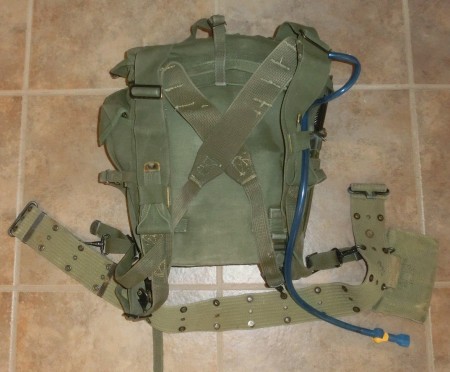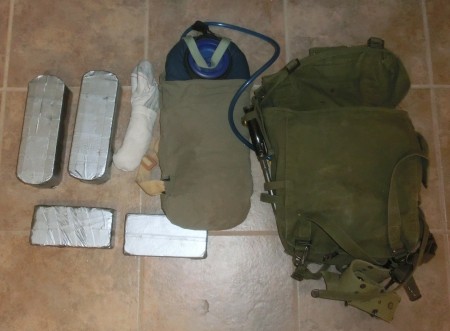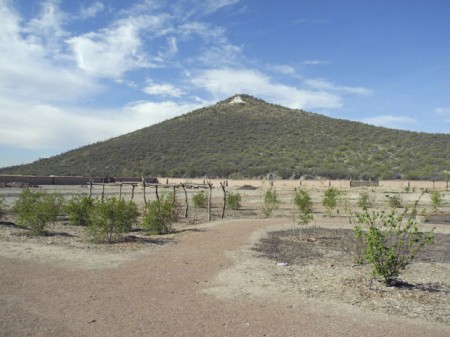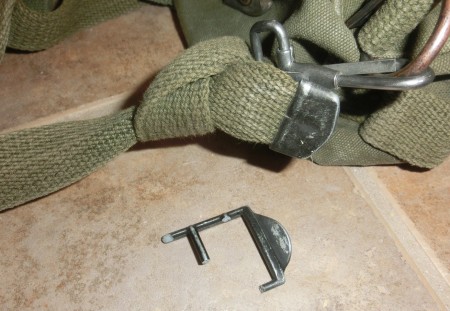I spent yesterday afternoon doing a GoRuck Light event – because it seemed like an interesting challenge. I do 5k runs regularly, and mud runs have been a lot of fun. This seemed like the next level up, and I was curious. As it turned out, it’s really not the same sort of event at all. The basic gist of GoRuck is a team-based march with weighted packs and exercises sprinkled in throughout.
When I decided to take part, I figured it would be an opportunity to try out some vintage gear a in real-life situation – I have a pattern 1945 US field pack that seemed like it would be the right size and ought to be durable enough. It was introduced too late to see much widespread use in WWII, but it was the standard pack for US troops in Korea, and was still in use in the early years of Vietnam. Now, backpack construction and standards have improve quite a lot in the 69 years since this thing was adopted. Today we have lightweight water-resistant materials, carefully designed suspension systems, padded supports, and so on. In 1945, the technology was all-canvas construction, no padding, and a waist belt whose sole job was to hang more weight on – not to help support the pack.

The GoRuck web site is pretty skimpy on details of what you will actually DO in their events, so I was a bit hazy on what to expect. I did know what had to go in the pack, though: water and bricks. Since I weigh more than 150lb, I was to carry 4 bricks, weighing 4-6 pounds each, and wrapped in duct tape to protect the pack interior. Water was an absolute necessity, and my 3-liter Camelbak just barely fit in the leftover space (that 1945 pack may be heavy and uncomfortable, but it isn’t very voluminous). I added in a spare pair of socks, a bayonet (there’s a tab for it right there on the side of the pack), and a bag of trail mix (in my pants cargo pocket for easy access). Considering that I was doing this to get a firsthand idea of just how much WWII and Korean War web gear sucked to use (or built character, if you prefer), it is worth noting that I was not carrying the additional cargo pack that hooks to the bottom of the field pack, canteens, ammo, a steel helmet, bedroll, entrenching tool, rifle, or other kit. My load was definitely the light version of an actual combat loadout (it weighed in at exactly 30lb).

The fun began with an introduction to different types of movement. First up – buddy carry. With packs, everyone carried a teammate about 75 yards. Then low crawl, run back, bear crawl, run back, crabwalk, run back. Then two 75m (roughly) lengths of walking lunges. I should also mention that there was a 15lb team weight that had to be carried at all times (it got passed around the team throughout the 6 or 7 hours we were doing this). There was also a nice big American flag and pole to be carried by the team at all times.
After the movement warmup, we went into a sequence of exercises. Oh, and we were introduced to the rule that for the rest of the day, none of our gear was allowed to touch the ground at any time. Letting it do so would result in penalty exercises. Anyway, the complete workout sequence was 24 each of pushups, flutter kicks (lie on your back with heels off the ground and alternate raising each leg), squats, military presses (hold your pack above your head and lift it up and down), and monkey****ers (take a wide stance and grab the insides of your ankles, and then alternate bending and straightening your knees). And lastly, the Tunnel of Love. Everyone gets in a circle with hands and feet on the ground and hips raised up (way up) in the air. Then in sequence, each person has to low crawl through the circle (twice). All of this, of course, with packs, lag, team weight, and without letting any gear hit the ground. And, of course, these were military count exercises – up, down, up, ONE; up, down, up, TWO – so we were actually doing double the number that was counted out.
That pretty much concluded the introduction, and we went from there into actual travel. We were given 75 minutes to get to “A” mountain (the summit that the University of Arizona has painted with a huge “A”) – approximately 4.5 miles from our starting point. Oh, and we were also informed that this was non-permissive territory, and so any time we came within 50m of a police, fire, or EMS vehicle or officer, we would have to stop and exercise (15 reps for a person, 25 for a vehicle, 50 for a building like a hospital or police station, again military count and thus actually doubled). That happened 6 or 8 times. Also, we were not allowed to use bridges. Road goes over a wash or river or arroyo? We go down and across.

We failed to make the destination in the allotted time, so we had to climb up to the top of the peak without using the pack straps. Had to carry pack cradled in the arms, balanced on the head or shoulder…but no straps for support. After the final push to the top, we got a few minutes to rest (but still, no gear allowed to touch the ground) before reversing course in the now-setting sun and taking a different path back to our starting point. Again, with only 75 minutes to cover the 4.5 miles. We successfully made the return time, by using a combination of fast walking and slow jogging. By this point, it sucked. A lot. I was having trouble with both calves alternatives charlie-horsing on me, and was pretty much hating life. Fortunately, since we made the time trial, we only had to follow it up with 200 arm circles (hold your arms horizontal out from your sides and rotate in small circles form the shoulder) and 150 flutter kicks (again, still military count and still without letting gear touch the ground).
So…back to the pack. The main shortcomings of the pattern 1945 field pack are its water-absorbent canvas construction, complete lack of padding, and lack of hip support. Once I started sweating, the back wall of the pack soaked it all up, and by the end of the evening left my lower back thoroughly shredded from rubbing. If we had been forced to get into water, it would have soaked up plenty of addition weight, and remained wet and heavy for hours (in fact, the back panel of the pack is still damp with sweat as I write this the morning after…ewww).
The heavy canvas construction did mean that it had no issues of fragility – the bricks presented no threat at all of tearing anything. However, I did have one equipment failure – the metal buckle on one of the connections to the waist belt snapped (I think it was during the Tunnel of Love). when I tried to jerry-rig it back into us, more of it snapped off – so I ended to just double-knotting the strap, which held for the rest of the day. I definitely did not expect a metal buckle to fail, but it clearly was too brittle.

How does the 1945 pack rate overall? Well, it would not be my first choice. Or second choice. But if it’s what you have, you can be pretty confident that it will get the job done. It will beat you up, but it will carry anything you can cram into it without tearing. The metal buckles are all pretty much optional, since the load is carried entirely be the canvas shoulder straps, which are thoroughly stitched to the pack. The 4 straps just hold the waist belt up, and that can be worn tight over the hips to support its own weight even if all the straps fail.
And how does GoRuck rate overall? If you are expecting something like a mud run on steroids, you are in for a surprise. It is much more accurate to call it a condensed sample of boot camp. It is a grinding physical challenge, and the mental challenge portion is basically just gutting it out and not quitting. We did have one guy who started but dropped out at the start of the bear crawl – he was rather out of shape, and having a really hard time. He wouldn’t let anyone else take his pack, and despite our attempts to get him to push through, he decided he was a burden to the team and left. I totally understand his mindset, but the purpose of the event is to work as a team and support the slowest teammate.
Ultimately, the concept is more rote physical hardship and less mental activity and variety than I really enjoy, and I don’t expect I will be doing another one (did I mention that the Light is the shortest and easiest event GoRuck puts on?). If I really wanted to do more of this, I would join the military, and get paid to do it. But it was an experience worth having, and it will make everything else I do for a long time feel a lot easier.

You should try this with the M1910 gear. The pack wraps up like a diaper and was designed to hold 6 #10 cans of food on the inside, a meat can pouch, a T handle shovel, and a bayonet (long) on the outside. There was an add on bit at the bottom to add a bedroll and the horseblanket coat went over the top. The ten pocket cartridge belt was required so that the shoulder straps had an anchor.
Good on ya for finishing! and no, I don’t blame you for not wanting to do another.
Scott
Yeah, I’ve tinkered with an M1910 pack. No thank you. 🙂
It sounds as if you were introduced to a condensed version of a typical forced march, with some tactical movement thrown in for good measure. A lot of old-time Paras ( “tabbing” ) and Royal Marines ( “yomping” ) would probably sympathize with you as well.
That old G.I.-issue backpack brought back some memories. When I was “in”, we had heavy-duty canvas rucksacks that were of a similar construction and configuration with the option of adding a detachable steel frame for stiffness and conformity. Most of us dispensed with the steel frame for the sake of greater long-term comfort, such as there was. Every item of equipment had to be carefully packed and secured to minimize noise generation, right down to the potential sloshing of drinking water in our canteens ( Camelbak-type rehydration systems hadn’t been invented yet ), and that took some effort, given the changes in load from one day to the next ( eg., consumption of “C” rations, “K” rations and other sundries ), which in turn necessitated continuous vigilance in re-packing and re-distribution of said loads.
Oh, and I should have mentioned that our friend Thomas, being the experienced old soldier that he is, would definitely understand and sympathize too.
I’m pretty sure that course wouldn’t hold a candle to what he’s done.
Perhaps not, but it still gives one a pretty accurate idea — on a macrocosmic level, if nothing else — of what it was like on the ground in terms of an extended combat deployment. On a more mundane note, I’m reasonably sure that my own operational experiences with the rucksack, et al, are in general agreement with those of other veterans.
We all have an inkling as to what was involved. at least in descriptive terms, for the Parachute Regiment and Royal Marines in the 1982 Falklands Campaign, and their collective experiences were hardly the first nor the last of the sort for any unit of any nationality that has ever fought a real battle or campaign, anywhere and at any time in recorded history. And that includes the Argentinian soldiers who fought bravely in the face of often overwhelming odds, and in a war they did not necessarily believe in.
Still, when the term “forced march” comes to mind in recent memory, the example of the Parachute Regiment’s advance to Goose Green in some of the most adverse environmental and geographic conditions under the pressures of war provides an outstanding example.
“Lest we forget” — please read ( or re-read ) the final poignant story of Stephen Hood, a member of 2nd Battalion, the Parachute Regiment, who passed on in January 2013. His widow, Carol, made it very clear that she knew what he had been going through after the war, and just as importantly, what other soldiers — both British and Argentinian — must still be experiencing. She also pleaded with the politicians of both sides to stop their posturing over the Falklands ( Malvinas ) issue for the sake of the veterans and, by extension, for the sake of common humanity. Please refer to http://www.dailymail.co.uk/news/article-2257792/Stephen-Hood-Iconic-hero-Goose-Green-kills-hours-Argentina-reignites-hostilities.html for more details.
I am sure that very similar stories exist from the Argentinian viewpoint, if only we had more general exposure to them. The Falklands War of 1982 was fought at the expense of the ordinary soldier — and, by extension, his/her family and society as a whole — regardless of which side he/her was on. Very much the same as for many conflicts in recent memory — a tragic waste of lives, effort and humanity for the sake of questionable gain by a few.
The time is about right to question the behaviour of the political class and their impact on the nation state. If the political class want conflict, it is they who should go to war, not the sheeple who are propagandised to follow their commands.
Precisely. Very well said!
Well done on completing, especially with that kit.
I don’t know how the US field pack compares to ’58 pattern webbing that was still current at the time of the Falklands but if it’s similar then it’s horrible. A good thing you used a camelback because getting the water bottle out of its pouch was a nightmare when wet. All the pouches shrunk and the webbing and tabs expanded which meant they didn’t fit in the buckles.
The fourth line from the bottom of my post should have read “regardless of which side he/she was on” — apologies for the error.
Well all that lark certainly keeps you fit, well done, suppose it’s enjoyable now and again. I’ve not done anything like that for awhile, I kinda want to but not.
Old rucksack as well, brave. I have thought about what it must have been like in the old days, no Gore-tex etc or modern sleeping bags when you see pictures of like Waterloo and stuff makes you wonder how they did it, old style boots etc even not that far back.
These Alice packs are good if you carrying small heavy stuff, like radios or ammo tins. Keep the sweat off your back more…
http://www.ebay.com/bhp/alice-backpack-frame
Way to go Ian. You finished and now have bragging rights and lots of stories to tell. Many supposidly in shape people today could not do that course. Congratulations.
Great job, Ian. If you haven’t found a source for them, you can get replacement ladder buckles from here: http://www.atthefrontshop.com/ProductDetails.asp?ProductCode=1fbn These are stamped rather than cast, so they are much stronger.
Nice job Ian! On the article and completing the event. If. I never realized how many cops are in Tucson until Saturday afternoon/evening!
Yeah, no kidding! 🙂
I used one of those M45 rigs as a Boy Scout. You either went with surplus gear or paid through the nose at the one official BSA outlet in town. I found my WWII stuff performed a lot better than the rather cheesy scout gear. I had a couple of vets in the family who showed me how to rig and pack the equipment to make it work the best. I still wouldn’t take it over the modern kit, however!
TNThompson,
Same here, while i was not in the Boy Scouts i grew up hiking the hills of northern Ca with an M45. Horrible kit, but better then a lot of store bought junk they pawned off on little kids. For quite a few years after i pretty much never used a back pack. All my friends though i was crazy but i would quite often make up an old fasioned bed roll. Very easy to carry around, actually supports a lot of weight.
Ian, you might get a kick out of the sniper adventure challenge and/or the Batan Death March memorial race.
Anyone who does the Bataan Death March Memorial race certainly has my respect – I’m not up for that. The sniper adventure challenge, maybe – once I’ve had a chance to hone my shooting skills more.
Mr. McCollum,
A question for you, you mentioned that the hardware on the bag was brittle and canvas stayed wet. If a version of this equipment was made with modern hardware and materials e.g. Fastec and Cordura, would you say that it would work in such applications? It seems like a decent design in desperate need of a modern touch.